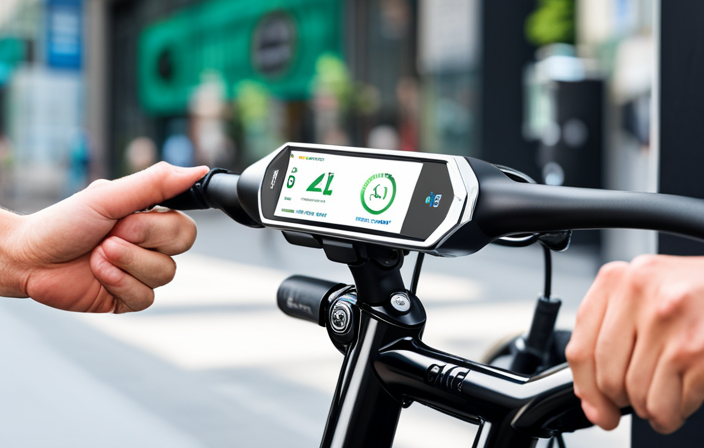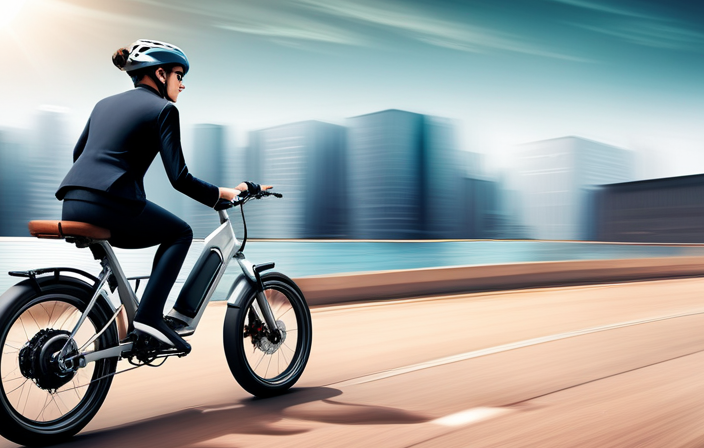Have you heard that Electric bikes are getting super popular lately? Sales are projected to hit 40 million units by 2025! Want to know more about this amazing trend? Keep reading to discover the secrets behind this growing trend and why you should consider joining the craze.
If you’re one of the many people who have recently purchased an electric bike, you may be wondering how to properly charge it.
In this article, I will guide you through the process of charging your electric bike, from understanding the battery type to finding a suitable charging location.
By following these steps, you’ll be able to keep your electric bike powered up and ready to go whenever you need it.
Key Takeaways
- Store the battery in a cool, dry place and avoid extreme temperatures, sunlight, and moisture.
- Use the recommended charger and avoid overcharging the battery.
- Regularly charge the electric bike after each ride, even if not fully depleted.
- Be mindful of limited charging stations in public places and promptly remove the e-bike once fully charged.
Understand the Battery Type of Your Electric Bike
You need to understand the battery type of your electric bike in order to charge it properly. Battery maintenance is crucial for the longevity and performance of your electric bike.
With the advancement in battery technology, there are various types of batteries used in electric bikes, such as lithium-ion, nickel-cadmium, and lead-acid. Each type has its own charging requirements and it is important to follow the manufacturer’s instructions for optimal charging.
Lithium-ion batteries, for example, should be charged regularly, even if they are not completely drained, to maintain their capacity. Understanding the battery type and its specific charging needs will ensure that you can properly charge your electric bike and get the most out of its battery life.
Now, let’s move on to finding a suitable charging location.
Find a Suitable Charging Location
Choose a convenient location to plug in your e-bike for charging.
When it comes to finding a suitable charging location, there are a few options to consider.
Firstly, you can look for nearby charging stations specifically designed for electric bikes. These stations are becoming increasingly common in urban areas and can provide a reliable and efficient charging solution.
Secondly, if you’re on the go and can’t find a charging station, you can charge your bike using a regular electrical outlet. Look for public areas such as parks, libraries, or shopping centers that offer accessible outlets for public use.
Lastly, consider installing a charging station at your home. This gives you the convenience of charging your bike whenever you need to.
Now that you know where to charge your bike, let’s move on to the next step: gathering the necessary charging equipment.
Gather the Necessary Charging Equipment
To gather the necessary charging equipment, start by checking if you have a compatible charger for your e-bike. Different electric bikes require different chargers, so it’s important to ensure that you have the right one.
Once you have a compatible charger, it’s important to understand the charging speed your e-bike can handle. Some chargers may offer faster charging speeds, but it’s crucial to choose a reliable charger that won’t damage your battery. Look for chargers that are specifically designed for your e-bike model, as they will provide the optimal charging experience.
Additionally, make sure to check the battery level before charging to avoid overcharging. This will help maintain the longevity of your battery and ensure efficient charging for your electric bike.
Check the Battery Level Before Charging
Before plugging in, it’s important to check the battery level of your e-bike. This step is crucial for battery maintenance and maximizing its lifespan.
To check the battery level, locate the battery indicator, which is usually located on the handlebar or near the battery itself. The indicator may display the battery level using bars, LED lights, or a numerical percentage. Take note of the current battery level to determine how much charge is needed.
It’s recommended to charge the battery when it reaches around 20% to 30% capacity to avoid deep discharging. Deep discharging can significantly reduce the battery’s lifespan.
Once you’ve determined the battery level, you can proceed to connect the charger to the battery for charging.
Connect the Charger to the Battery
To connect the charger to the battery of my electric bike, I first plug in the charger into the designated charging port on the battery.
It is important to ensure that the charger is properly connected to the battery to avoid any charging issues or damage.
Once the charger is securely plugged in, I can proceed with the charging process and wait for the battery to fully recharge.
Plug-in the Charger
Simply plug in the charger to charge your electric bike. Before doing so, it is important to ensure that you have taken the necessary precautions to maintain your battery and follow charging safety guidelines.
This includes regularly checking the battery for any signs of damage or wear, and keeping it clean and dry. When plugging in the charger, make sure that the charger is compatible with your electric bike’s battery and that it is securely connected. It is also important to find a suitable power outlet that is not overloaded and has the correct voltage.
Once plugged in, the charger will begin charging the battery. To ensure proper connection, it is recommended to keep an eye on the charging progress and monitor any potential issues that may arise.
Now, let’s move on to the next step of ensuring a proper connection.
Ensure Proper Connection
Make sure you’ve plugged in the charger securely to ensure a proper connection. It is important to use a charger that provides the proper voltage for your electric bike to avoid any damage. Before connecting the charger, check the voltage requirements specified by the manufacturer. Once you have confirmed the correct voltage, plug the charger into a power outlet. To ensure a secure connection, make sure the charger’s plug fits snugly into the charging port of your electric bike. A loose connection can result in interrupted charging or even damage to the battery. Additionally, it is crucial to follow safety precautions while charging your electric bike. Avoid charging in wet or humid environments, and keep the charger away from flammable materials. Once you have ensured a proper connection and taken the necessary safety precautions, you can proceed to monitor the charging process.
Now, let’s move on to the next step and learn how to monitor the charging process.
Monitor the Charging Process
Keep an eye on the charging process of your electric bike by monitoring the battery levels regularly. This is crucial for ensuring the optimal charging of your bike’s battery.
Here are some monitoring techniques you can use to maximize the charging efficiency:
-
Use a battery monitor: Install a battery monitoring device that displays the current battery level and charging status.
-
Check the charging time: Keep track of how long it takes for your battery to reach a full charge. This will help you identify any potential issues or abnormalities.
-
Monitor temperature: Be aware of the battery’s temperature during the charging process. Excessive heat can negatively impact the battery’s lifespan and performance.
-
Observe charging patterns: Notice any patterns in the battery’s charging behavior. This can help you optimize the charging process for maximum efficiency.
By closely monitoring the charging process, you can avoid overcharging the battery and ensure its longevity and performance.
Avoid Overcharging the Battery
After monitoring the charging process, it is essential to avoid overcharging the battery of your electric bike. Overcharging can lead to decreased battery lifespan and potential damage.
To maximize the battery’s lifespan, it is crucial to be mindful of the charging time and disconnect the charger once the battery is fully charged. Most electric bike chargers have indicator lights that show when the battery is fully charged.
Once the charging is complete, it is important to unplug the charger from the power source and remove it from the battery. By avoiding overcharging, you can ensure that your electric bike’s battery lasts longer and performs optimally.
Now, let’s move on to the next step and learn how to store the battery properly after charging.
Store the Battery Properly After Charging
Once the battery is fully charged, it is important to store it properly to maintain its longevity. Proper battery storage is crucial in maximizing the battery lifespan and ensuring its optimal performance.
Here are three important tips for storing your electric bike battery:
-
Keep the battery in a cool and dry place: Extreme temperatures can negatively affect the battery’s performance. Therefore, it is recommended to store it in a cool and dry place away from direct sunlight and moisture.
-
Avoid storing the battery at full charge: It is advisable to store the battery at around 50% charge. Storing it at full charge for long periods can lead to capacity loss and reduce its overall lifespan.
-
Regularly check the battery: Even when not in use, it is essential to periodically check the battery’s charge level and ensure it does not drop too low. This helps to prevent deep discharge and potential damage.
By following these proper storage practices, you can ensure the longevity of your electric bike battery. Understanding the charging time and range is the next step to maintaining your electric bike’s optimal performance.
Understand the Charging Time and Range
Understanding the charging time and range is essential for maintaining optimal performance of your e-bike battery. The charging speed of your electric bike can vary depending on the charger and battery capacity. It is important to use the recommended charger provided by the manufacturer to ensure safe and efficient charging.
Faster charging can shorten the battery life, so it is crucial to find a balance between charging speed and maximizing battery life. Additionally, knowing the range of your e-bike is important to plan your rides and avoid running out of battery power.
Taking precautions while charging, such as avoiding extreme temperatures and using a surge protector, will help prolong the lifespan of your battery. Transitioning into the next section about taking precautions while charging, it is important to follow these steps to ensure safe and efficient charging.
Take Precautions While Charging
To ensure safe and efficient charging, it’s important to take precautions while plugging in your e-bike battery.
First and foremost, always use the charger provided by the manufacturer and ensure it is compatible with your specific model. Avoid using generic chargers, as they may not provide the correct voltage or current, which could damage your battery.
Additionally, make sure to charge your e-bike battery in a well-ventilated area, away from flammable materials. It’s also crucial to avoid overcharging your battery, as this can lead to reduced battery life and potential safety hazards.
Finally, never leave your battery unattended while charging, as it could pose a fire risk. By following these safety measures during charging, you can ensure the longevity and reliability of your e-bike battery.
Now let’s move on to troubleshooting any charging issues.
Troubleshoot Charging Issues
If you are experiencing any issues with charging your e-bike battery, there are several troubleshooting steps you can take.
First, ensure that the charger is securely plugged into both the wall outlet and the charging port on your bike. Check for any loose connections or damaged cables that may be preventing a proper charge.
If the charger appears to be working correctly, try using a different outlet to eliminate the possibility of a faulty power source.
Additionally, make sure that the battery is properly seated in its compartment and that all connections are secure.
If none of these steps resolve the issue, it may be necessary to consult the manufacturer or a professional for further assistance.
By troubleshooting common charging problems, you can optimize charging efficiency and extend battery life.
Extend Battery Life
After troubleshooting any charging issues with your electric bike, it’s important to consider ways to extend the battery life and maximize its performance. By implementing a few simple practices, you can significantly increase the lifespan of your battery. Firstly, avoid overcharging your battery, as this can lead to decreased capacity over time. Secondly, try to keep your battery at a moderate temperature, avoiding extreme hot or cold conditions which can negatively impact its performance. Additionally, it’s recommended to store your bike with a partially charged battery, around 50-80%, if you won’t be using it for an extended period. This helps to prevent the battery from fully discharging, which can cause irreversible damage. By following these tips, you can ensure your battery lasts longer and provides optimal performance. To further maintain your electric bike’s battery, it’s crucial to charge it regularly.
Charge Your Electric Bike Regularly
Make sure you regularly plug in your e-bike for charging to maintain its battery health. Understanding battery capacity is crucial for maximizing charging efficiency.
Most electric bikes have a lithium-ion battery, which is best charged regularly to ensure its longevity. It is recommended to charge the battery after each ride, even if it is not fully depleted. This helps prevent the battery from fully discharging, which can negatively impact its overall capacity.
Additionally, it is important to use the charger provided by the manufacturer and avoid using quick chargers, as they may cause damage to the battery. By following these practices, you can ensure that your e-bike’s battery remains in optimal condition.
Understanding charging etiquette in public places is also essential to maintain the longevity of your battery, so let’s dive into that next.
Understand Charging Etiquette in Public Places
To maintain a respectful charging experience in public places, it’s important to understand the etiquette surrounding charging your e-bike.
When charging in public, it’s crucial to be mindful of the limited charging stations available. It’s essential to only use the charging station for the necessary time and promptly remove your e-bike once it’s fully charged. Avoid leaving your bike plugged in for an extended period or using the charging station as a parking spot.
Additionally, be considerate of others who may be waiting to charge their electric bikes and allow them the opportunity to use the station. By following these guidelines, we can ensure that everyone has a fair chance to charge their bikes and avoid unnecessary conflicts.
Once your electric bike is fully charged, you can enjoy the benefits of a longer ride and a more efficient mode of transportation.
Enjoy the Benefits of Your Fully Charged Electric Bike
Now that you have a fully charged e-bike, you can fully enjoy the benefits of a longer ride and a more efficient mode of transportation.
-
Maximize Battery Performance: To get the most out of your electric bike’s battery, make sure to follow these tips. Avoid extreme temperatures, as they can impact battery performance. Keep your battery charged between 20% and 80% to prolong its lifespan. And always use the correct charger provided by the manufacturer.
-
Troubleshoot Common Charging Problems: If you encounter any issues while charging your electric bike, here are a few common problems and their solutions. If the charger doesn’t seem to be working, check the power source and make sure it’s properly connected. If the battery doesn’t hold a charge, it might be time to replace it. And if you’re experiencing slow charging, try using a different outlet or charger.
By maximizing battery performance and troubleshooting common charging problems, you can ensure a smooth and enjoyable experience with your electric bike.
Happy riding!
Frequently Asked Questions
How often should I charge my electric bike?
You should charge your electric bike battery whenever it is low or after each ride. This will help maximize the lifespan of your battery and ensure it lasts longer. Here are some tips for maximizing your electric bike battery life.
Can I charge my electric bike using a regular power outlet?
Yes, you can charge your electric bike using a regular power outlet. It’s one of the convenient charging options available. The charging time may vary depending on the battery capacity and charger specifications.
Is it safe to leave my electric bike charging overnight?
Leaving an electric bike charging overnight can be potentially dangerous as it may lead to overcharging the battery, causing overheating or even a fire hazard. It is essential to follow the manufacturer’s guidelines and consider the charging times and efficiency of different electric bike models.
What should I do if my electric bike battery doesn’t hold a charge?
If my electric bike battery doesn’t hold a charge, I would first try troubleshooting techniques like checking the connections and ensuring proper charging. If that doesn’t work, battery replacement options could be considered for a reliable solution.
Are there any specific charging etiquette guidelines for public places?
Charging stations are available in many public places for electric bikes. It’s important to be mindful of charging etiquette in residential areas, such as not blocking access to outlets and being considerate of others’ charging needs.
Conclusion
So there you have it, charging your electric bike is a simple yet crucial task that requires a bit of knowledge and preparation. By understanding your battery type, finding a suitable charging location, and gathering the necessary equipment, you can ensure a smooth charging experience.
Remember to check the battery level before charging, connect the charger properly, and extend the battery life through regular charging. Lastly, be mindful of charging etiquette in public places.
Now, imagine the freedom and joy of riding your fully charged electric bike, ready to explore the world around you. Happy riding!









